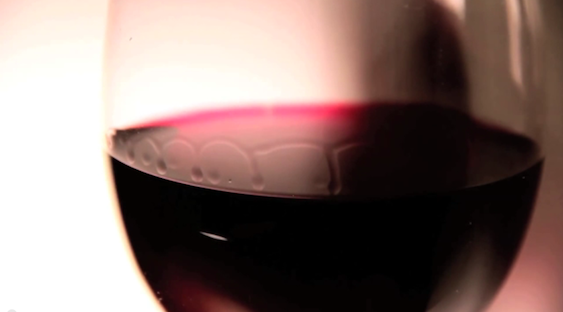You may be a boob man or an ass man, but when it comes to wine, we’re all leg men (or women).

What exactly are legs when it comes to wine? Photo credit: BinBin.
Depending on how often you hang out in winery tasting rooms eavesdropping on pretentious conversations, you might have heard the term “legs” thrown into conversation about wine…usually as someone who has no idea what they’re talking about tries to look knowledgeable by peering intently at a glass of wine they have just swirled.
When someone refers to the “legs” of a wine, he or she is talking about those streaks of liquid that run down the side of the glass after you swirl it. Some people think that the thicker or more pronounced those legs, the higher the quality of wine.
False. Though folks tend to examine the color, thickness and viscosity of the legs, the only things they really indicate are the alcohol and sugar levels in the wine. That said, try daring someone to guess the alcohol percentage of a wine simply by examining the legs. If they get it right, chances are they snuck a peek at the bottle’s label when you weren’t looking!

Wine legs are actually caused by surface tension. Image credit: Dan Quinn/YouTube.
If you really want to dork out about it, the phenomenon is a result of the different surface tensions between water and alcohol, two of the main components of wine. When you swirl that glass of wine, you are creating a thin layer of liquid on the inside of the glass. The alcohol in that liquid evaporates quicker than the water in it, leading to those streaks or droplets. This, in turn, increases the surface tension of the more watery liquid on the sides of the glass compared to the liquid still sitting in the bottom of the glass (water’s surface tension is greater than that of alcohol).
Because of that increased surface tension, more liquid from the main part of the glass is drawn up into those streaks on the side of the glass before it streams back down under its own weight. This is called the Gibbs-Marangoni effect and was discovered by physicist Lord Kelvin’s older brother, James, in the 19th century. I told you it was dorky.
So the next time you splash some wine around in a glass, by all means enjoy the spectacle, but don’t try to infer too much from the legs that form…and don’t let anyone else fool you into thinking that they can either!
If you absolutely must talk about the legs of a particular wine, I challenge you to refer to them the way folks in various parts of the world do by calling them by other names such as fingers, curtains, or, as in the case of France and Spain (and probably after a bad break-up), tears. Bonus points if you manage to call them church windows like they do in Germany!

